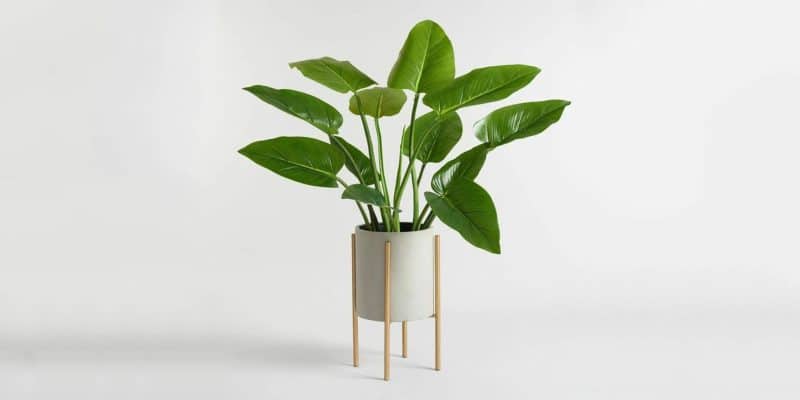Say hello to the fabulous Philodendron Imperial Green! With its rich, emerald leaves and easy-to-care-for nature, this gorgeous tropical superstar is bound to become the envy of your indoor jungle.
This stunning houseplant not only packs a visual punch, but it’s also a breeze to care for, making it the ideal choice for newbies and green-thumbed aficionados alike.
This is your go-to guide for understanding the ins and outs of Philodendron Imperial Green care, propagation, and handling pesky pests. Whether you’re a seasoned plant parent or just starting your collection, you’ll walk away feeling like a true Philodendron pro.
Table of Contents
Philodendron Imperial Green Plant Care Guide
History, Habitat, and Characteristics
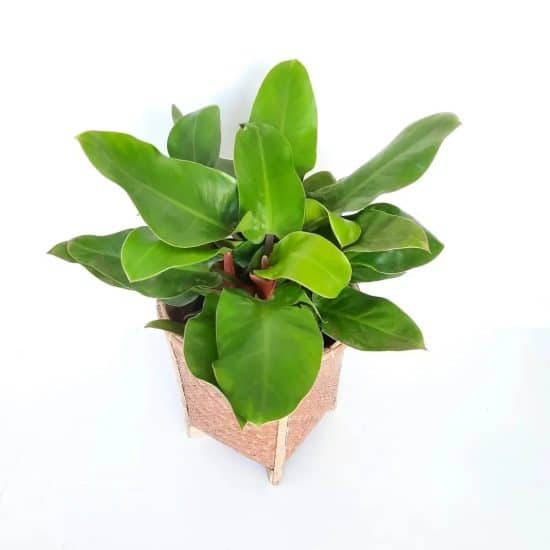
Philodendron Imperial Green (Philodendron erubescens ‘Imperial Green’) sports eye-catching glossy green leaves with a vibrant green hue. It’s a cultivar of Philodendron erubescens, which hails from the verdant rainforests of Central and South America. This houseplant is known for being friendly and adaptable.
As a self-heading plant, Philodendron Imperial Green is always ready to explore new heights (although it doesn’t vine). Outdoors, it often latches onto surfaces using its aerial roots, which provide additional support as it grows.
Indoors, though, you don’t need to provide it with a moss pole — its stems are thick enough to support it!
The color of this plant’s leaves is nothing short of a marvel. As a youngster, the leaves start off sporting a bright green shade. As they mature, they gradually transition into a deeper, richer green — talk about growing up gracefully!
Now, you might wonder if there’s more to this tropical plant than its good looks. The answer is a resounding yes! Philodendron Imperial Green is not just a pretty face; it’s also an air purifier extraordinaire. It actively works to remove harmful toxins like benzene, making it an ideal roommate for bedrooms and living spaces.
This houseplant also has a red-hued cultivar sibling, the Philodendron Imperial Red. Both varieties share similar care requirements and an undeniable flair for brightening up their surroundings.
Fun fact: Philodendron Imperial Green is a hybrid cultivar variety, which means it was bred by horticulturists to be perfectly suited for indoor conditions. It’s truly a wonder of the plant world, making it a delightful addition to any plant collection, from novice growers to experienced gardeners.
Light
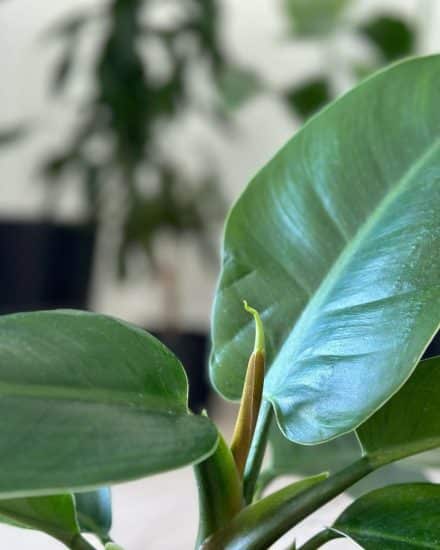
To keep Philodendron Imperial Green plants flourishing, it’s important to mimic their native habitat in your home.
Although these tropical plants are often considered low light plants, Imperial Greens in fact prefer bright indirect sunlight, ideally from a north or east-facing window, for better growth and leaf production.
When your Philodendron Imperial Green receives too much direct sunlight, its leaves may appear faded or sun-bleached, and small holes can develop. This can even cause leaf burn on the delicate foliage. In this situation, consider moving your plant to a spot with less direct sun or using a sheer curtain to filter the strong rays.
However, if your Philodendron Imperial Green isn’t receiving enough light, you’ll likely notice slow, leggy growth and smaller leaves. To remedy this, try relocating your plant to a brighter location or using a grow light (preferably an LED full-spectrum light) to supplement natural light, promoting healthy plant growth.
Water
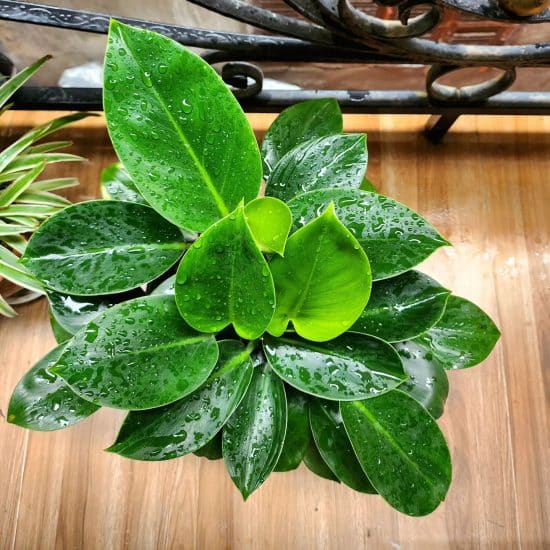
Philodendron Imperial Green watering isn’t complicated — you’ll know it’s time when the top two inches of soil feel dry (warm and loose, not moist). For best results, use room temperature water, and if you have access to rainwater, even better! Just ensure it reaches room temperature before using it on your plant.
Opting for a plastic pot can help retain moisture, as this plant prefers not to go very dry.
When watering in semi-hydro, be watchful for any yellow leaves, signaling it’s time to discard the water and let the plant rest for at least four days. This way, you can avoid overwatering issues.
If your plant is not receiving enough water, the leaves may wilt, curl up, and the oldest leaves (those at the bottom) can turn yellow. In this case, increase your watering frequency and remove any dying leaves to keep pests at bay.
On the other hand, if your Philodendron Imperial Green is receiving too much water, you’ll notice yellowing leaves throughout the plant and potentially mushy stems. The soil might remain moist for long periods, so in this situation, reduce the watering frequency.
If you see brown leaf tips followed by small brown and black spots on the leaves, you may be dealing with root rot. Remember to let the soil dry out before watering your Philodendron Imperial Green again.
Temperature and Humidity
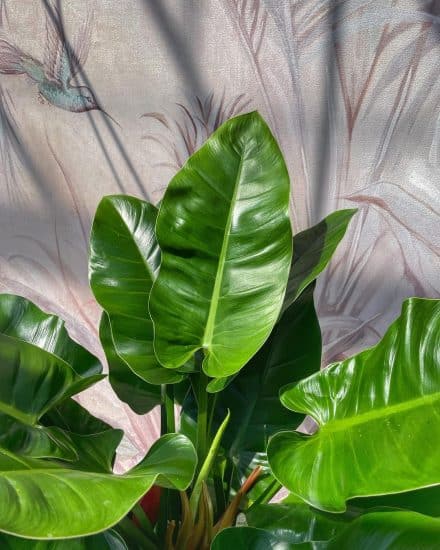
Originating from South America, the Philodendron Imperial Green prefers a warm, tropical environment. Aim for a temperature range of 65-80°F (18-27°C) to make your plant feel right at home.
Be mindful that this low maintenance plant is sensitive to cold drafts, so it’s essential to shield it from sudden temperature changes. If you see your Philodendron Imperial Green near a frequently opened window or door, consider relocating it to a cozier spot.
Temperature stress signs in your Philodendron Imperial Green include wilting, leaf damage, and browning leaf tips. If you observe any of these symptoms, adjust the temperature to bring your plant back to a comfortable setting.
Imperial Green Philodendrons adore high humidity environments, so strive for a humidity level of 60-80%. Drooping, curling leaves, or brown spots may indicate that the humidity is too low. Conversely, mold or fungal diseases on the plant or soil could be a sign of excessive humidity.
To raise humidity:
- Set your Philodendron Imperial Green plant on a tray of water and pebbles, allowing the evaporating water to provide humidity.
- Group your Imperial Green with other plants, creating a microclimate where they share moisture.
- Increase the room humidity level with a humidifier.
- Mist the leaves regularly, but wipe off excess water to prevent mold or mildew.
Soil and Planting
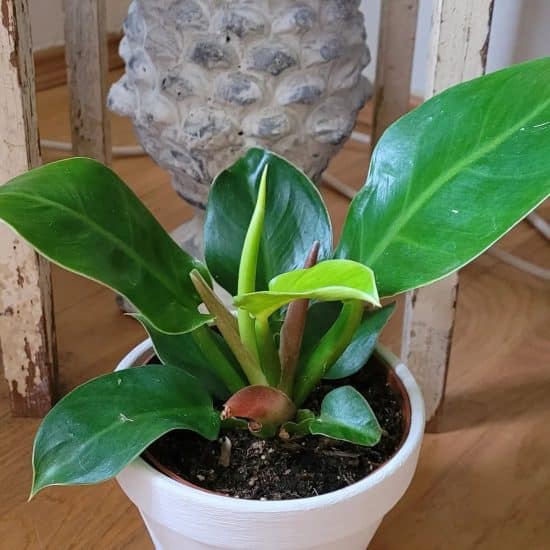
Caring for your Philodendron Imperial Green, a self-heading plant, starts with selecting the appropriate potting soil mix to ensure proper drainage and nourishment.
Here’s what to include in your fresh potting mix:
- Coconut coir. This component retains moisture while ensuring sufficient aeration for the plant’s roots, making it ideal for these tropical indoor plants.
- Pumice. Adding pumice increases drainage and prevents waterlogging — a must for keeping your Philodendron Imperial Green healthy and happy.
- Worm castings (optional). Including worm castings in the soil mix provides natural nutrition to promote growth and overall plant health.
Fertilizing
For added nutrition, supplement your Philodendron Imperial Green care regimen with a seaweed liquid fertilizer or tablets as an alternative to traditional chemical fertilizers.
Be sure to watch for signs of too much fertilizer, such as yellowing leaves, stunted growth, or a white crust on the soil surface. If this happens, simply cut back on the fertilizer and consider flushing the soil with water to remove excess nutrients.
When planting your Imperial Green Philodendron, first check for any dead roots, dead leaves, or earthworms. Gently pinch off any dead roots and clear away unwanted elements before placing the plant in a suitable pot with drainage holes.
A climbing pole in the middle of the pot will help support its growth and encourage a fuller look.
Propagation
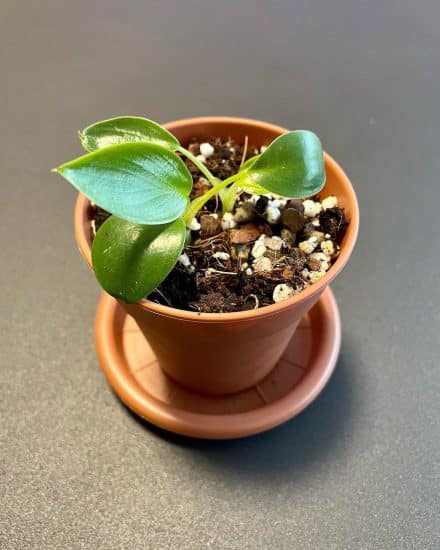
Propagate Philodendron Imperial Green in either water or soil to expand your indoor jungle or share this rare plant with friends and family. We’ll include some helpful tips for success along the way!
Propagating Philodendron Imperial Green with stem cuttings in water:
- Select a healthy stem from your plant that has at least two or three leaves, and with sterilized scissors or gardening shears, make a clean cut just below a leaf node. Aim for a 4-6 inches long cutting.
- Remove the lower leaves, leaving only one or two leaves at the top. This allows the stem to focus its energy on growing roots instead of maintaining extra foliage.
- Place the cutting in a small container filled with filtered water. Remember to change the water every 2-3 days and put the container in a spot that receives bright, indirect light.
- Keep an eye on those roots. In a few weeks, you should see roots growing from the nodes. When they reach about 2 inches long, your cutting is ready to be transplanted to a potting soil mix.
Propagating Philodendron Imperial Green with stem cuttings in soil:
- Grab a small pot with a soil mix that drains well and drainage holes to prevent overwatering and root rot.
- Plant the cutting with the bottom node just below the soil surface, gently pressing the soil around the cutting to hold it in place.
- Water the cutting to keep the soil moist consistently, but not waterlogged. Place the pot in a warm area that receives bright, indirect light, avoiding direct sunlight that could harm the leaves.
- Watch for new growth, a sign that your cutting has successfully taken root. A few weeks later, you can start treating your new Philodendron Imperial Green like a mature plant, with regular watering and fertilizing.
Our propagation tips:
- When picking a Philodendron Imperial Green stem to propagate, make sure it has healthy, mature leaves and shows no signs of pests or diseases, such as bacterial leaf spot.
- The best time for propagating your Imperial Green Philodendron is during its growing season, in spring or summer, when it’s actively putting out new growth.
- Philodendron Imperial Green plants thrive in high humidity, so consider providing extra humidity while propagating.
- Patience is key! Root development may take a few weeks, so give your cutting some time to establish a strong root system.
- Once your new Imperial Green Philodendron plant is established, ensure it gets the care it needs, including proper watering, fertilizing, and avoiding hot and cold drafts.
Common Issues
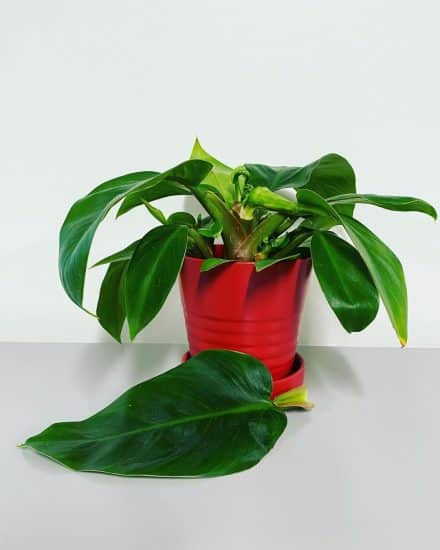
Philodendron Imperial Green is generally an easy-to-grow houseplant, but it can encounter a few challenges.
Yellow Leaves
Dealing with yellow leaves on your plant? You may wonder, is my Philodendron Imperial Green dying? Don’t worry! This can be caused by overwatering, abrupt environmental changes, or improper soil moisture levels.
To tackle this issue, first eliminate any standing water and then let the plant dry out for a few days before watering again. It’s essential to use soil where water flows freely, trim off the discolored or misshapen leaves, and think about repotting your plant in an aerated mix (which helps maintain adequate soil moisture).
And remember, providing bright light and a balanced Philodendron Imperial Green fertilizer are crucial for a healthy plant.
Dusty Leaves
At first glance, dusty leaves on your Philodendron Imperial Green may seem like a minor problem. However, they can actually impede your plant’s ability to absorb light and even attract unwanted pests.
To clean the dusty leaves, gently use a damp cloth or sponge to wipe them down, being cautious not to cause any damage. Establishing a regular cleaning routine can help keep dust at bay, and placing your Imperial Green Philodendron away from high-traffic or dust-prone areas is another effective strategy.
If you find persistent dust or pesky insects such as spider mites, consider using a natural insecticidal soap like neem oil (which not only keeps your plant tidy but also safeguards its health).
Pests and Diseases
Although your Philodendron Imperial Green is fairly pest resistant with its strong pine-like smell, it might still face some challenges, such as root rot and pests. We’ll discuss how to identify and tackle these issues to keep your imperial green philodendron healthy and thriving.
Pests
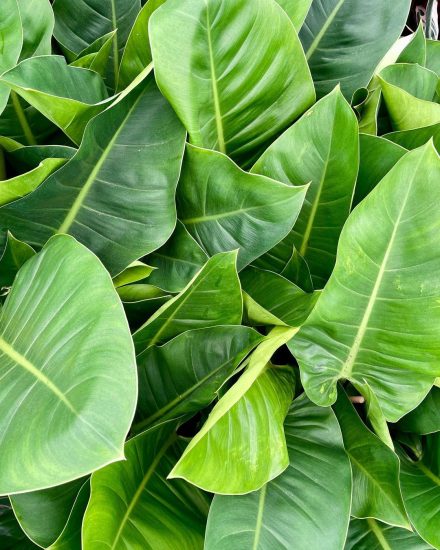
The Philodendron Imperial Green doesn’t attract many pests, but it’s essential to keep an eye out for them anyway (better safe than sorry). Check the bottom of the leaves for any suspicious markings or tiny critters, and remove affected parts if you spot them.
Your philodendron might occasionally face mealybugs, aphids, spider mites, or scale insects.
If pests have invaded your plant, here’s what to do:
- Isolate the affected plant from your other houseplants to avoid spreading the infestation.
- Gently wipe off pests from leaves and stems using a damp cloth.
- In the case of a serious infestation, apply an insecticidal soap or neem oil to your plant (just follow the directions on the label).
- Keep monitoring your Philodendron Imperial Green for any recurring pests, and re-treat as needed.
Root Rot
Root rot is a common issue for your Philodendron Imperial Green, especially when the soil stays moist for too long (overwatering or poorly draining soil are the main culprits here). Harmful bacteria and fungi love this environment, so it’s crucial to take action quickly.
To check for root rot, carefully remove your Philodendron Imperial Green from its pot and examine the roots. If you spot browning, mushy, or dead sections, that’s a clear sign of root rot.
Don’t worry! Here’s how to fix root rot:
- Trim away the affected roots using clean scissors or pruning shears (remember to sterilize them before and after to prevent spreading the disease).
- Create a well-draining soil by mixing potting mix with perlite or pumice (this improves aeration and drainage).
- Repot your Philodendron Imperial Green into a clean pot with the new soil mixture, ensuring it has proper drainage holes to prevent water from pooling.
- Only water your plant sparingly, when the top layer of soil feels dry (this will help prevent root rot from returning).
Keep an eye on your Philodendron Imperial Green for pests and take action quickly if you spot root rot. This way, you can help maintain your plant’s growth while keeping it healthy and lush, allowing it to continue growing beautifully.
Conclusion
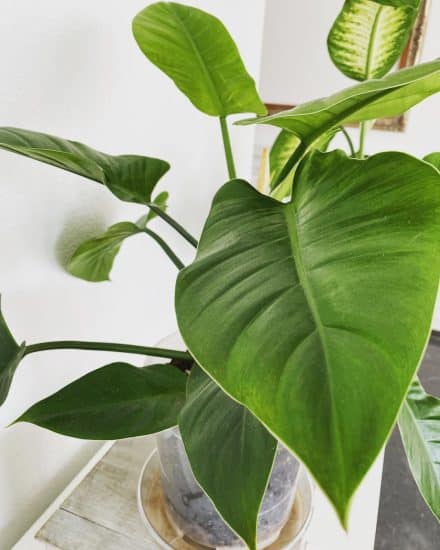
And there you have it — our comprehensive Philodendron Imperial Green care guide!
This gorgeous houseplant is not only a stunning visual addition to any space, but also an easy-to-grow companion for plant lovers of all skill levels.
Philodendron Imperial Green care summary:
- Opt for bright, indirect light to keep those luscious leaves vibrant and healthy. Avoid direct sunlight to prevent scorching the foliage.
- Ensure well-draining soil to prevent root rot and maintain consistent moisture levels. Be mindful not to overwater your plant.
- Keep the temperature range between 65-80°F (18-27°C) and aim for a humidity level of 60-80% to mimic its natural habitat.
- Regularly monitor your Philodendron Imperial Green for pests and root rot, addressing any issues as they arise.
- Experiment with both water and soil propagation methods to multiply your plant collection or share with friends and family.
We hope this guide helps you confidently grow and care for your Philodendron Imperial Green. If you have any questions or concerns that weren’t covered here, please don’t hesitate to reach out — we’re always here to help!
Share this guide with fellow plant enthusiasts, and let’s create a thriving plant community together.
Take care, and happy growing!
FAQ
How do you take care of a Philodendron Imperial Green?
Philodendron Imperial Green needs moderate to bright indirect light, water it when the top two inches of soil are dry, and make sure it’s in normal household temps and humidity. Oh, and fertilize it two to three times during each growing season. That’s it!
How big can Imperial Green Philodendron get?
Under the most ideal conditions, Philodendron Imperial Green can grow anywhere from just under 3 to just under 4 feet tall indoors. Individual leaves can grow up to 18 inches long and 8 inches wide. Outdoors, it can grow anywhere from 10 to 20 feet tall!
Is Philodendron Imperial Green a climber?
No. Unlike other Philodendron, the Imperial Green is self-heading, which means it grows upright, supports itself on thick stems, and doesn’t vine.
Is Philodendron Imperial Green easy to care for?
Yes, growing Philodendron Imperial Green is very easy. They thrive in normal household humidity and temperatures, only require fertilizer two or three times per growing season, and require water when many other plants do, when the top half of the pot’s soil is dry.

